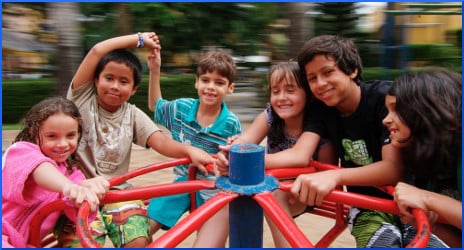
Much of our current understanding of the childhood obesity crisis comes from highly respected institutions. To pick a random example, after research was done at Harvard Medical School and the Harvard School of Public Health, the authors made suggestions about what two different groups should do.
They would like to see a collaboration between the Food and Drug Administration, the Federal Trade Commission, and Congress, with the objective of regulating all marketing that is directed toward children. Another goal would be to repurpose the Farm Bill to subsidize fruits and vegetables. Also, primary-care physicians are encouraged to face reality — childhood obesity is “one of the most prevalent chronic diseases.” The Harvard researchers would like to see more cooperation between their fellow scientists and the medical profession, the advocates of public health, experts from the area of business and law, and of course parents.
Room to move
Joanna Rothkopf of Salon reported on a recommendation that in most places would take a lot of community support to implement: increased availability of public lands for people to actually use for activities like hiking and trail biking. Researchers from the state universities of both Missouri and Minnesota looked at some Minnesota towns. Rothkopf says:
The study found that counties with more trails and forests had higher levels of youth activity and lower youth obesity than counties with fewer opportunities for outdoor recreation.
The trouble is, in urban areas, trails, parks, and playgrounds seem to have become increasingly likely to harbor crime rather than healthy exercise. Parents can contribute greatly to the community and help reduce childhood obesity by advocating and supporting safe, accessible recreational space in all neighborhoods.
The great outdoors
For Outside Online, Katie Arnold reported on the message of Peter Gray, PhD. In the American Journal of Play, he summarized what is to be learned from two University of Michigan studies about children’s play. Gray conveyed the news that between 1981 and 1997 children’s total play time diminished by 25% and outdoor playtime was cut in half. Guess how much time per day the average contemporary child spends “goofing off outdoors” — between 4 and 7 minutes.
Sure, kids have school sports — the ones who can afford the uniforms, equipment, and other expenses. But one of the reliable sources of exercise enjoyed by previous generations — walking to and from school — has almost become extinct.
In his research, Gray posits that children who don’t play are more likely to suffer from anxiety and depression; childhood obesity and diagnoses of attention-deficit disorders are on the rise. Play teaches children how to work together and mature into more socially well-adjusted adults; it has also been proven to build better brain function and improves academic performance.
Dr. Stuart Brown, a psychiatrist and clinical researcher who founded the National Institute for Play, calls play “a fundamental survival aspect of all social animals.” Through his research of homicidal males in the 1960s, he found that a lack of “normal give-and-take play behaviors” may even be an indicator for mass violence.
Arnold urges parents to put their kids outside more, and even offers helpful instructions for the forgotten art of communicating with other parents about visits and guidelines for safety.
So if parents wonder how to commemorate Childhood Obesity Awareness Month, here is a clue. Work toward the establishment and maintenance of useful, safe play areas in your neighborhood, and encourage not only your own children but others to get out there and run around.
Your responses and feedback are welcome!
Source: “Kids are what they eat,” Harvard.edu, 09/26/12
Source: “How the built environment is contributing to childhood obesity,” Salon.com, 09/11/14
Source: “America Needs a Playtime Intervention,” OutsideOnline.com, 08/27/14
Image by guilherme jofili

 FAQs and Media Requests:
FAQs and Media Requests: 











